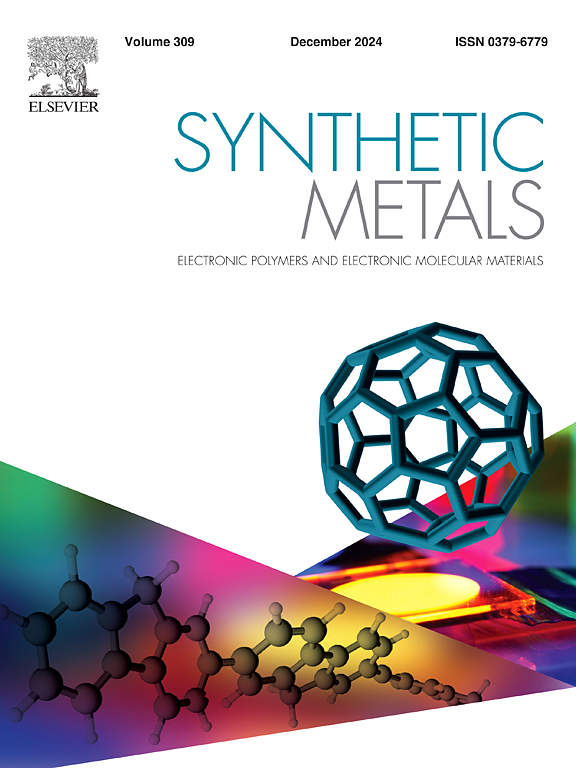用于室温乙醇气体传感器装置的双金属纳米颗粒PEDOT:PSS薄膜的稳定性和性能增强
IF 4.6
3区 材料科学
Q2 MATERIALS SCIENCE, MULTIDISCIPLINARY
引用次数: 0
摘要
本文介绍了一种室温下工作的乙醇蒸汽传感器的开发,该传感器是基于poly (3,4-etilenodioxitiofeno) poliestireno sulfonato (PEDOT:PSS)薄膜,该薄膜由沉积在多层结构中的双金属银(Ag)和金(Au)纳米颗粒(Np)修饰而成。Ag-2/Au-3/PEDOT:PSS薄膜的响应速度为43.1 %,响应时间为48 s,恢复时间为78 s,而纯PEDOT:PSS薄膜的响应速度分别为40 %,88 s和132 s。扫描电镜形貌分析显示,平均粒径为5.1 nm (Ag-2/Au-3)和3.7 nm (Au -3 /Ag -2),紫外可见光谱显示等离激元共振峰位于540 nm和542 nm。x射线衍射证实了银和金结晶相的存在。硫k边的NEXAFS光谱显示Ag−2/Au−3的电子离域时间较长(高达10.15 fs),这与PEDOT链的低取向有关,因此与乙醇的相互作用更大。2 V白光发光二极管照明导致74 %的检测响应增加和更大的稳定性,在10个周期后仅退化5 %,相比之下,没有照明的17 %。采用热途径合成纳米颗粒,而不是化学途径,导致感官反应略有增加,这归因于颗粒尺寸的减小。结果表明,双金属纳米颗粒和等离子体激发在提高传感器灵敏度和稳定性方面具有重要作用。本文章由计算机程序翻译,如有差异,请以英文原文为准。
Enhanced stability and performance of PEDOT:PSS films with bi-metallic nanoparticles for room-temperature ethanol gas sensors devices
This work presents the development of ethanol vapor sensors operating at room temperature, based on Poli(3,4-etilenodioxitiofeno) poliestireno sulfonato (PEDOT:PSS) films modified with bimetallic silver (Ag) and gold (Au) nanoparticles (Np) deposited in a multilayer structure. The devices made with the Ag-2/Au-3/PEDOT:PSS configuration showed superior performance, with a response of 43.1 %, response time of 48 s and recovery time of 78 s, compared to the pure PEDOT:PSS film, with a response of 40 %, 88 s and 132 s, respectively. Morphological analysis by Scanning Electron Microscopy indicated average particle sizes of 5.1 nm (Ag-2/Au-3) and 3.7 nm (Au−3/Ag−2), while UV-Vis spectroscopy revealed plasmon resonance peaks at 540 nm and 542 nm. X-ray diffraction confirmed the presence of crystalline Ag and Au phases. NEXAFS spectra at the sulphur K-edge revealed a longer electronic delocalization time for Ag−2/Au−3 (up to 10.15 fs), associated with the lower orientation of the PEDOT chain and, consequently, greater interaction with ethanol. Illumination with a 2 V white Light-Emitting Diode led to a 74 % increase in detection response and greater stability, with degradation of only 5 % after 10 cycles, compared to 17 % without illumination. Adopting a thermal route for nanoparticle synthesis, rather than the chemical route, resulted in a slight increase in sensory response, attributed to the reduction in particle size. The results highlight the bimetallic nanoparticles and plasmonic excitation in improving the sensitivity and stability of the sensors.
求助全文
通过发布文献求助,成功后即可免费获取论文全文。
去求助
来源期刊

Synthetic Metals
工程技术-材料科学:综合
CiteScore
8.30
自引率
4.50%
发文量
189
审稿时长
33 days
期刊介绍:
This journal is an international medium for the rapid publication of original research papers, short communications and subject reviews dealing with research on and applications of electronic polymers and electronic molecular materials including novel carbon architectures. These functional materials have the properties of metals, semiconductors or magnets and are distinguishable from elemental and alloy/binary metals, semiconductors and magnets.
 求助内容:
求助内容: 应助结果提醒方式:
应助结果提醒方式:


